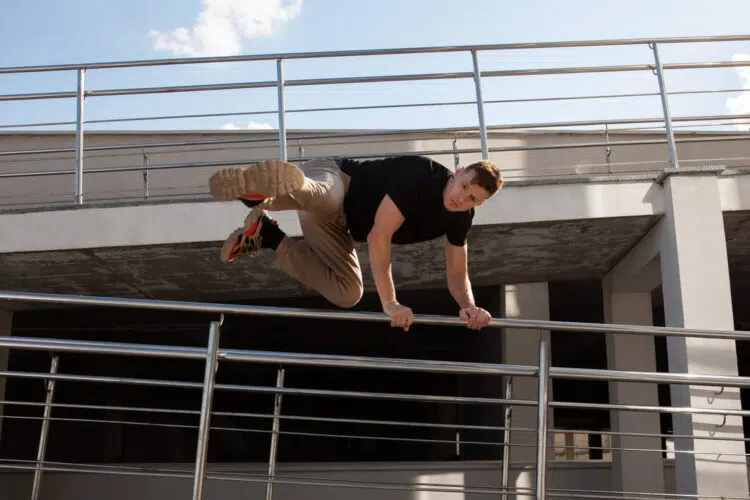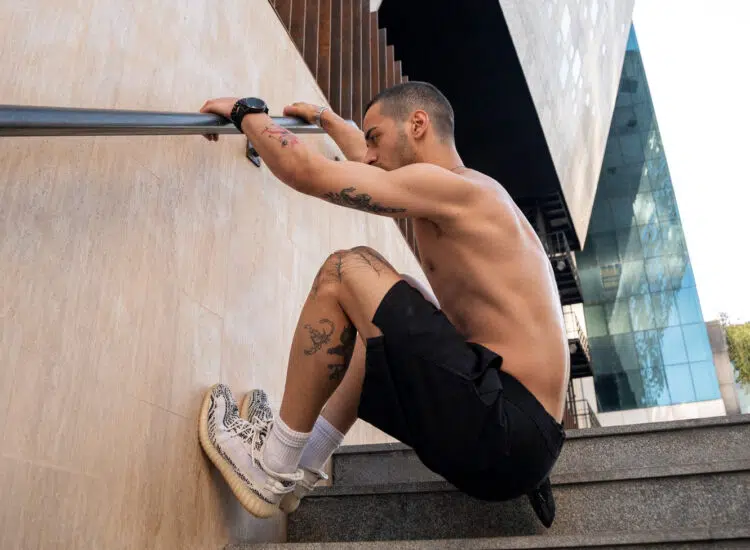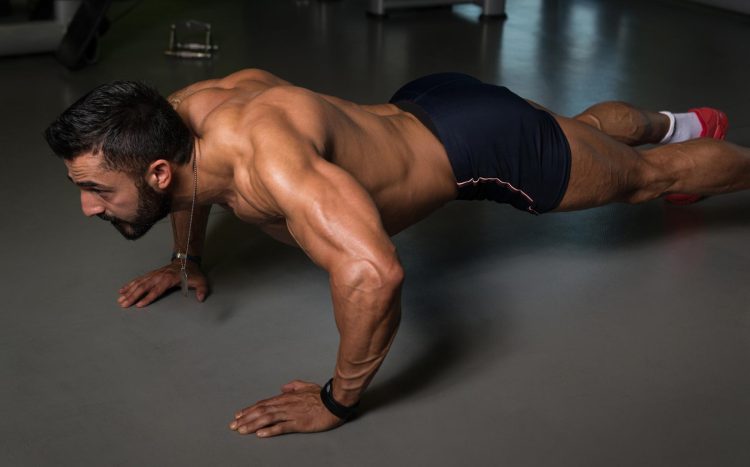The modern landscape is turning into a concrete jungle. The good news is that it is still a jungle, at least. While we might not have trees and vines to swing from, the urban landscape offers its own unique challenges and opportunities.
Parkour training is a unique and dynamic approach to movement, fitness, and urban exploration.
Trivia: Parkour was born in the suburbs of Paris and has now turned into a philosophy involving how to interact with the world around you.
Parkour involves moving through an environment to get from one point to another as quickly and efficiently as possible. It comprises a variety of movements, including running, climbing, jumping, rolling, vaulting, and swinging.
Contrary to what most people think, parkour isn’t limited to jumping between buildings.
Parkour has its roots in martial arts and military obstacle course training, which is why it looks so badass.
Level Up Your Fitness: Join our 💪 strong community in Fitness Volt Newsletter. Get daily inspiration, expert-backed workouts, nutrition tips, the latest in strength sports, and the support you need to reach your goals. Subscribe for free!
One of the best things about parkour is that it is a non-competitive sport and prioritizes safely adapting to the environment while overcoming obstacles. Art, creativity, vision, and showmanship are a big part of parkour. You want to make your runs look as smooth and appealing as possible.
In this article, I take you over everything you need to know about parkour training, including the foundational movements, how to build strength, conditioning, and athleticism for this sport, and tips on how to make consistent gains.
Difference Between Parkour and Freerunning
Many use parkour and freerunning interchangeably. However, they are two distinct sports. The former prioritizes efficiency and practicality, with the goal being to get from one point to the other as quickly and efficiently as possible.
On the other hand, freerunning is more about self-expression and creativity. It usually involves using movement to express oneself while exploring the environment. Acrobatic flips and tricks are a big part of freerunning.
Parkour training emphasizes fluid, controlled movements with a focus on momentum.
While a freerunner might take a more creative approach to cross a busy street by incorporating flips and spins, a traceur (parkour practitioner) will find the most efficient way to navigate the obstacle.
Although they are two different sports, they share some similarities. Many athletes involve elements of both disciplines in their training.
Benefits of Parkour Training
But why jump over walls and slide down railings when you can simply stroll to your destination?
I’m glad you asked. Here are the benefits of adding parkour training to your routine:
Builds Strength and Agility
Scaling a wall is no easy task. Pulling your body weight up and over a wall requires significant strength and agility. You must start small and gradually increase the training difficulty to maximize your strength gains, balance, coordination, and endurance.
There is a lot of chatter about functional fitness in the strength sports community. Parkour training streamlines it.
Furthermore, research suggests that parkour training can improve fundamental movement skills in people, improving their day-to-day performance. These skills can also be carried over to more demanding activities like sports. (1)
Sharpens Your Mind
Parkour requires you to make decisions constantly. You must continuously analyze if you should slide over a stationary car’s bonnet, jump over the fire hydrant, or squeeze through a railing.
It’ll teach you how to stay on your toes and boost your focus and decision-making skills. I believe that parkour training is one of the best ways to build real-time problem-solving abilities. Since everything is happening so fast, you get a knack for working in high-pressure situations.
Adaptability
Unlike most strength training programs that require particular training equipment, parkour training has no such demands.
It doesn’t matter if you live in the remotest part of the earth. You can practice parkour as long as you have stuff around you. Another great thing about it is that you can take it at your own pace. Start with basic movements and progress to more challenging techniques as you gain more experience and get more confident.
Improves Athletic Performance
A study published in the Frontiers in Physiology journal found significant correlations between performance in performance in parkour speed runs and basketball-specific tests (vertical jump, T-test) performance. It also improved cardiorespiratory fitness measures like peak oxygen uptake and anaerobic threshold. (2)
Fun
Let’s be honest here for a second. Parkour training is incredibly fun. Unlike doing the same things over and over again, as is the case with most conventional gym training routines, you’ll likely be doing new things every day in your parkour training program.
Variability makes a training regime more exciting. People are more likely to stick to a training program when they are having fun compared to when they are just dragging their feet through each session. (3)
4 Foundational Parkour Movements
Parkour training isn’t about reckless city navigation. It demands control, precision, and calculated movements with military precision. Begin your parkour journey with the basic techniques listed below:
Safety Rolls
This is one of the most basic movements in parkour and involves tucking into a roll to lessen the impact of a fall, landing, or unexpected obstacle. You’ll be doing a ton of rolls in your parkour training, so you should spend the time to master the movement mechanics.
- Land with your feet shoulder-width apart and your knees slightly bent.
- Bring your hands down in front of your feet.
- Tuck your chin into your chest, push off with your legs, and roll diagonally across your back from one shoulder to the opposite hip.
- Stand upright using the momentum in a fluid motion.
Vaulting
This is one of the cooler parkour movements and involves using your hands to propel yourself over obstacles. There are three main vaulting techniques you should know about:
Level Up Your Fitness: Join our 💪 strong community in Fitness Volt Newsletter. Get daily inspiration, expert-backed workouts, nutrition tips, the latest in strength sports, and the support you need to reach your goals. Subscribe for free!
- Speed vault: Suitable for quickly going over low obstacles.
- Lazy vault: It is ideal for conserving energy while trying to overcome medium-height obstacles.
- Kong vault: You use this method to scale higher obstacles using power and momentum.
Spend the time to master different types of vaults, as it can significantly improve your overall performance.
Wall Running
As someone who is not the most comfortable with heights, wall running is one of the most challenging aspects of parkour for me. Nonetheless, this technique allows you to scale vertical surfaces and cross them.
I recommend starting with low walls and running on it for shorter distances. Increase the wall height and running distance as you gain more skill, strength, and confidence.
Precision Jumps
In contrast to popular opinion, parkour isn’t just about raw power. You must prioritize control and accuracy. For instance, using too much force can lead you to vault over a wall instead of mounting and running on it.
Precision jumps force you to slow down this adrenaline-pumping sport. Here, you will focus on landing exactly where you intend to. Some common targets include a small ledge or a precise point on a railing.
This movement is a test of your body awareness and an understanding of your own limits.
All said and done, parkour training is incredibly risky. I highly recommend starting with the easier movements. Plus, beginners should seek a professional’s help to minimize the risk of injury.
Developing Body Awareness
Like everything else in parkour, improving your body awareness is a skill and you must practice it regularly to get better at this sport. This is how it can help you:
Understanding Your Capabilities
Each individual has their unique strengths. Some are naturally flexible, while others are gifted with incredibly explosive power. You must begin by understanding your strengths and capitalizing on them.
While you must push your limits in this sport, avoid going overboard, as the risk of getting hurt goes through the roof.
Spatial Awareness and Risk Assessment
Parkour training requires quick decision-making. Making life-changing decisions on the fly doesn’t get any better than this.
To do this, you must develop the ability to quickly analyze your environment and make decisions based on your sensory inputs and experience — known as sensory awareness. You must develop a deep understanding of distances and heights and how they intertwine. The objective is to reach a point when all these calculations become second nature.
Assess the risks and potential consequences of your training regime and proceed only if you are completely safe.
Developing Proprioception and Balance
Proprioception is your ability to sense your body’s position and movement in space without relying solely on your vision.
If you are looking to test or challenge your balance and coordination, there is no better way to do it than parkour training. Over the long haul, parkour will help improve these crucial senses, which will boost your overall functionality and performance.
Strength and Conditioning for Parkour
Parkour is an incredibly demanding and complex training regime. Besides practicing the foundational movements, you must incorporate regular strength and conditioning training into your lifestyle to meet the demands of the sport. Let’s go over some of the most essential strength training and flexibility drills that should be a part of your routine.
Essential Strength Training Protocols
Add the following exercises to your arsenal table overall strength:
- Bodyweight exercises: Beginner-friendly movements like push-ups, bench dips, air squats, and pull-ups are a great way to build strength and endurance.
- Plyometrics: These exercises involve explosive movement to build power and agility. For example, jump squats, box jumps, and medicine ball throws.
- Core strengthening: A robust core is non-negotiable for good balance, stability, and coordination, which are essential for parkour training. Make planks, crunches, and Russian twists a staple in your training routine.
Importance of Flexibility and Mobility
A lack of mobility can hinder your parkour performance.
Practice performing each parkour, strength, training, and core exercise with a full range of motion to ensure optimal performance and safety. Restricted range of motion can lead to tight muscles, which can increase your risk of injury.
I highly recommend making dynamic stretching a part of your warm-up routine. It will boost blood flow to the target muscles and warm up the joints, significantly limiting the risk of getting hurt during explosive movements.
Learn to listen to your body. Discontinue an exercise if something feels weird or uncomfortable. Consult your healthcare provider if you are experiencing pain, and it doesn’t subside within a couple of days.
Shoe Consideration For Parkour Training
Shoes are a critical aspect of parkour training, as there is a lot of running and jumping involved.
Experts recommend using classic running shoes with single-piece rubber soles, flexible front, and non-elevate heels when starting out in this sport. Furthermore, this training style can quickly wear out the shoes, and you must replace them at the first sign of wear and tear.
Training in unsupportive or unsafe shoes can significantly increase injury risk.
Remember, you must take it one day at a time. Parkour is a highly challenging training discipline that requires years of consistent practice. Start slow, focus on using the right technique, and gradually increase the challenge to allow your body enough time to adapt.
Conclusion
Parkour training is an incredibly effective way to boost physical and mental empowerment. It allows you to unleash your inner ninja, improving your overall agility and strength.
Make no mistake: parkour training isn’t just about scaling buildings. It’s about overcoming obstacles, both physical and mental. Parkour training also fires up the right hemisphere of the brain, sparking creativity and spatial ability.
Like every other training style, parkour training requires consistency, dedication, and discipline. Find a suitable urban playground, start small, and stick to your training routine, and the results will follow. Give yourself at least eight to 12 weeks to adjust to the new regime.
If you have any questions about parkour or need help implementing it into your routine, post them in the comments below, and I’ll be happy to help!
References:
- Dvořák, M., Eves, N.D., Bunc, V., & Baláš, J. (2017). Effects of Parkour Training on Health-Related Physical Fitness in Male Adolescents. The Open Sports Sciences Journal, 10, 132-140.
- Williams MD, Strafford BW, Stone JA, Moran J. Parkour-Based Activities in the Athletic Development of Youth Basketball Players. Front Physiol. 2021 Oct 15;12:771368. doi: 10.3389/fphys.2021.771368. PMID: 34721090; PMCID: PMC8554233.
- Williams MD, Hammond A, Moran J. Beyond athletic development: The effects of parkour-based versus conventional neuromuscular exercises in pre-adolescent basketball players. PLoS One. 2023 Jul 12;18(7):e0288439. doi: 10.1371/journal.pone.0288439. PMID: 37437087; PMCID: PMC10337934.











